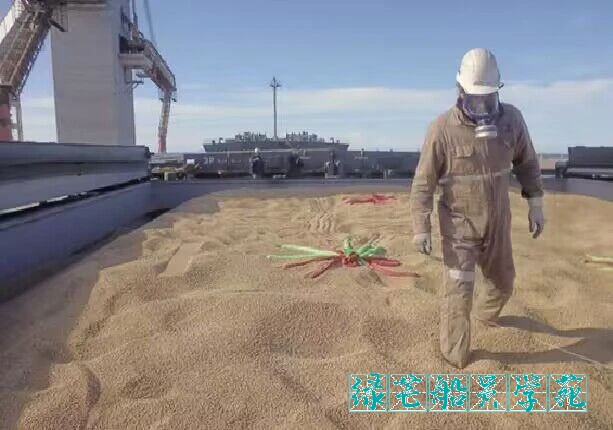船舶熏舱期间注意事项及操作规程
货舱熏舱作业操作要点注意安全|规范操作|谨防火灾/爆炸

船舶在装运粮食/木材时,往往会在密封的货舱中投放一定量的磷化铝、磷化钙、磷化锌等杀虫剂进行熏蒸以杀死昆虫或其虫卵。无论是码头熏蒸还是随航熏蒸,操作不当会导致包括火灾/爆炸及人员伤亡在内的事故,比如:
When shipping grain/wood, a certain amount of aluminum phosphide, calcium phosphide or zinc phosphide are often placed in the sealed cargo hold to kill insects or their eggs. Improper handling of fumigation residues can lead to accidents including fire/explosion and casualties, such as:
01
某轮从泰国装运木薯干在开航5天后一号舱因磷化铝熏蒸剂遇水发生爆炸;
Vessel carrying dried cassava from Thailand exploded 5 days after its departure due to the exposure of aluminum phosphide fumigant to water.
02
某轮在港卸大豆期间,因船方对货物熏蒸剂残渣处置不当发生遇水燃烧事件,且使用灭火剂不当,造成熏蒸剂更加剧烈燃烧。
During the unloading of soybeans in port, due to improper disposal of fumigant residue, burning occurred. Improper use of fire extinguishing agent resulted in more intense burning of fumigant.
03
某轮装载大豆到达卸货港锚地锚泊期间,水手长和两名水手擅自进入货舱后发生船员磷化氢中毒事故,造成水手长死亡,其余二人受伤。
A ship loaded soybeans arrived at the unloading anchorage, Bosun and two ABs entered the hold without permission and were poisoned by phosphine. Bosun died and the other two were injured.
04
某船在开往澳大利亚途中因所有船员受货舱散发的熏舱毒气影响不得不紧急靠岸救治。
A ship en route to Australia had to be emergency berthed for medical treatment after all its crew were affected by fumes from the cargo hold.
05
某轮在东南亚装载木薯粉后的航行熏舱途中,11人受毒气影响而中毒死亡,其他人员在紧急靠岸后进行救治。
Eleven crew died after being poisoned by the gas in a fumigation hold with cassava in SE Asia. Others were landed ashore for medical treatment.
货舱熏蒸操作要点
货舱熏蒸,船舶应严格根据IMO通函及IMSBC 规则相关要求进行操作, 以确保安全及顺利营运。鉴于货舱熏蒸的危险性,公司整理一些操作要点如下,请大家参考。
Fumigation shall be carried out in strict accordance with requirements of IMO Circular Letter and IMSBC Regulations to ensure safe and smooth operation. In view of the danger of fumigation residues, we have sorted out key points as follows for your reference.
1
在抵港前,一旦确认熏舱,船上要立即进行检查,确保货舱、生活区、机舱没有任何可能导致薰舱毒气进出的开口或缝隙。比如各密封胶条、舱壁、焊缝、道门盖、管弄接头、老旧船的舱口围壁板、污水井通道阀等均完好无损。舱盖进行皮龙和粉笔测试。任何不适合熏舱的缺陷,立即汇报、整改。
Before arriving, once fumigation plan is confirmed, immediately inspect shall be implemented to ensure no openings or gaps in cargo hold, accommodation and engine room that may be the passage of fumigation gas. Such as sealing rubber strips, bulkheads, welds, covers, pipe joints, hatch coaming panels, bilge well access valves, etc., are intact. Hatch cover shall be tested with fire hose and chalk. Any defects not suitable for the fumigation shall be reported and rectified immediately.
2
船长和参与熏舱的船员提前学习并理解海安会《关于适用于货舱熏蒸的船上安全使用杀虫剂的建议案》,对于不甚理解的问题可以提前询问熏舱公司人员得以确认。Master and crew participating in fumigation should learn and understand the Recommendations on the Safe Use of insecticides onboard Applicable to fumigation issued by MSC in advance. Ask the fumigation company for confirmation in advance if in doubt.
3
船长和大副要提前培训所有船员,介绍熏舱情况及注意事项。培训包含:熏舱物的材料安全数据单内容,危险等级和可能引起的爆炸、火灾和中毒风险,诱发风险的因素以及操作注意事项、危险处理程序。培训记录要完整并报告船东。Master and CO should train all the crew in advance, introduce the situation of the fumigation and matters needing attention. The training includes content of MSDS, danger grade and possible explosion, fire and poisoning risks, factors inducing risks, operation precautions and hazardous treatment. Training records should be completed and reported to the owner.
4
参与熏舱的船员要熟悉用于熏蒸的设备,了解气体测量的步骤和防护措施,阅读处理熏舱材料残余的说明,检查防护服等设备的密封性等。Crew involved in fumigation shall be familiar with the equipment used for fumigation, understand the steps of gas measurement and protective measures, read the instructions for handling material residues in fumigation, and check the tightness of protective clothing and other equipment.
5
除必要人员外,其它人员不能进入熏蒸区域;进行熏蒸毒气测量等必要人员必须按照熏舱安全操作要求穿戴必要的防护装备后才能进入熏蒸区域。Except for essential crew, other crew are not allowed to enter the fumigation area. Necessary crew for fumigation gas measurement must wear proper protective equipment in accordance with the requirements before entering the fumigation area.
6
整个航程中按照要求对生活区各层、机舱靠近货舱场所、货舱附近空间进行气体浓度的安全检测,检查结果应记录在船舶日志中;同时,每班应对所有船员的健康状况进行检查并记录,一旦船员出现恶心/呕吐/乏力/头疼/胸闷/胸疼及呼吸困难等症状,船长应首先考虑该船员是否中毒并按照应急程序采取行动。During the whole voyage, gas concentration tests shall be carried out on each floor of accommodation, engine room place adjacent to the hold and the space near the cargo area. Inspection results shall be recorded in the log. Meanwhile, the health status of all crew members shall be checked and recorded on each duty. Once the crew show symptoms of nausea, vomiting, fatigue, headache, chest tightness, chest pain and breathing difficulties, master shall first consider whether the crew are poisoned and take action as per emergency procedures.
7
大风浪天气涌浪的击打可能使货舱舱盖位移导致毒气泄漏,因此应在恶劣天气过后立即对货舱区域进行测量。The impact of swell in rough weather may cause the hatch cover to shift and lead to gas leakage. Therefore, the cargo hold area should be measured immediately after the bad weather.
8
除非在特别紧急时,不得在海上打开或者进入正在进行封闭熏蒸的货舱。Do not open or enter a closed fumigation hold at sea except in an extraordinary emergency.
9
熏舱期限到了以后进行通风,可能使舱盖及舱壁上凝结汗水,接触熏蒸药品可能发生化学反应和/或火灾。不应在熏蒸期限到后立即对货舱进行通风,而是在条件许可的情况下要求船东/租家安排专业人员将货舱内的熏蒸药品等取出后再进行通风及日常货物管理。Ventilation after the expiration of the fumigation period may cause sweat condensation on the hatch cover and bulkhead. Wet contact with fumigation drugs may cause chemical reactions and/or fire. Ventilation of the hold should not be carried out immediately after the fumigation period. Instead, if conditions permit, the ship owner/charterer should be required to arrange professional crew to remove fumigation residues etc. from the hold before ventilation and routine cargo management.
10
货舱通风时必须使船舶顺风(使风从船尾吹向船首), 生活区各门需要紧闭,仅允许参加过熏舱公司培训的人员穿戴好防护装备后参加通风,其他无关人员不得在通风现场。When ventilating the cargo hold, the ship must be downwind (wind blowing from the stern to the bow), all accommodation doors must be closed, and only crew trained by the fumigation company are allowed to take part in the ventilation after wearing protective equipment, and other irrelevant crew are not allowed in the ventilation site.
11
如果船舶不得不配合船东/租家在抵达港口前的一两天内把货舱内的熏舱药品残余取出,船长和大副必须进行风险评估并指导船员进行安全操作:先进行毒气测量,穿戴安全防护装备并戴干净的纯棉手套,低腰慢慢地将装有药品的袋子等收集起来, 不能扬尘。If the ship is obliged to cooperate with the owner/charterer to remove the remains of fumigation drugs from the cargo hold within a day or two prior to arrival, master and CO must conduct a risk assessment and instruct the crew in safe operations: gas measurements, wearing safety protective gear and clean cotton gloves, slowly collecting bags of drugs, etc. at a low waist without blowing dust.
12
熏蒸残余物如果必须由船员进行, 则应采取安全措施:If fumigation of residues must be removed out by crew, safety measures should be taken:
1根据制造商的指示或者在装货港负责熏舱的人员的指示处理废弃物;
Dispose of wastes according to the instructions of the manufacturer or the person in charge of fumigation at the loading port;
2含有还没反应的药品的废弃物应作为危险废弃物处理,应予以特别小心地处理;一般情况下,需要等待其惰性化后才能处理;
Waste containing unreacted pharmaceutical products should be treated as hazardous waste and should be handled with special care. In general, you need to wait for it to be inert before processing;
3除非船员有技能判定药品是否已经反应,应谨慎地在其惰性化后且按照制造商关于这一程序的明确指示才能处理;Unless the crew has the skill to determine whether or not the drug has reacted, it should be handled discreetly after it has been inert and in accordance with the manufacturer's express instructions regarding this procedure;
4熏舱废弃物及残余不能放置在潮湿的开敞甲板上,不能放置在封闭的桶内或者容器内,不能放置在潮湿的开敞桶内,不能将装有熏舱废弃物及残余的开敞的桶放置在某个空间或者库房内;
The waste and residue of the fumigation shall not be placed on the wet open deck, shall not be placed in the closed bucket or container, shall not be placed in the wet open bucket, shall not be placed in the open bucket containing the waste and residue of the fumigation in a certain space or store;
5所有参加薰舱废弃物及残余收集的人员必须经过培训的且穿戴好防护装备;
All crew involved in the collection of waste and residue must be trained and wear PPE;
6尽可能使船舶横向受风,参加人员应从上风开始工作;As far as possible to make the ship transverse wind, participants should enter from the windward;
7应在干燥的天气且甲板不能上浪的时候进行。This should be done in dry weather and when the deck is free from waves.
13
熏蒸的货舱进行卸货作业时,如需有人在货舱对卸货机械进行处理或者操作(比如修理,开铲车等),必须对熏蒸的空间进行连续的监控并确保安全,作业人员必须穿戴合适的呼吸保护装备。
During unloading from fumigated hold, if someone needs to handle or operate the unloading machinery in the cargo hold (such as repair, forklift, etc.), continuous monitoring of the fumigated space must be carried out to ensure its safety, and operators must wear appropriate respiratory protection equipment.
14
因同一货舱内不同的地方,磷化氢的含量不尽相同甚至差异甚大,货舱内的毒气含量测量必须尽可能各个点全部测量;同时,进入货舱人员应足够谨慎。卸货的最后阶段,当需要人员进入货舱时,必须在确认货舱已经没有熏舱/熏蒸气体时或者足够安全并穿戴安全防护装备才能许可人员进入。
Because the content of phosphine is not the same or even very different in different points in the same cargo hold, the gas in the cargo hold must be measured at all points as far as possible. Meanwhile, crew entering the cargo hold should be with cautious. In the unloading final stage, when crew are required to enter the hold, they shall be allowed to enter only after confirming that the hold is free of fumigation/fumigation gas or is safe enough and wearing safety protective equipment.
15
必须检查船上的所有消防系统及设备并使之处于良好的工作状态;如果有任何缺陷,必须在熏蒸开始前解决。
All firefighting systems and equipment on board must be inspected and kept in good working order. If there are any defects, they must be settled before fumigation begins.
16
货舱熏蒸结束后,应将货舱相邻处所经常进行旺盛通风。由于熏舱毒气的比重比空气重而下沉,在货舱相邻处所进行作业时不仅要严格按照密闭空间作业的程序进行,还应特别注意该处所可能存在熏舱毒气。
After the fumigation of the hold, the adjacent space of the hold should be ventilated frequently and vigorously. Since fume gas is heavier than air and sinks, the operation in the adjacent space of the cargo hold should not only strictly follow the procedures of confined space operation, but also pay special attention to the possible presence of fume gas in the space.
航运事故的发生,往往后果严重,避免事故重在预防。希望船上的管理级人员及各位现场作业的参与人员,在进行作业之前,一定要做好风险评估,落实法规及公司体系规定,预判可能存在的风险并且采取积极主动的应对措施,如此才能确保人员、设备及环境安全,顺利完成作业。
The shipping accidents often result with serious consequences, prevention is the key to avoid accidents. Hoped that before carrying out the key operation, the management crew on board and the participants in the field operation must do a good risk assessment, implement the regulations and regulations of the company ISM, anticipate the possible risks and take proactive measures, so as to ensure the safety of crew, equipment and environment and successfully complete the operation.
- 发表于 2023-04-25 20:23
- 阅读 ( 2362 )
- 分类:海员培训
你可能感兴趣的文章
相关问题
0 条评论
文件生成中...
请稍候,系统正在生成您请求的文件

船舶熏舱期间注意事项及操作规程

扫码过程中请勿刷新、关闭本页面,否则会导致支付失败
购买后请立即保管好,30天后需重新付费。

船舶熏舱期间注意事项及操作规程

扫码过程中请勿刷新、关闭本页面,否则会导致支付失败
购买后请立即保管好,30天后需重新付费。
请点击下载或复制按钮进行操作
